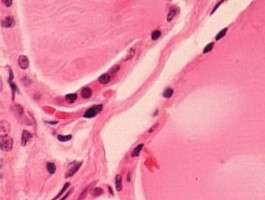
The phase 2 trial PrE0405 met its primary endpoint, achieving a complete response (CR) rate of 85% in 33 patients over the age of 60 with mantle cell lymphoma (MCL) who received bendamustine and rituximab, a standard chemo-immunotherapy treatment, along with venetoclax, which is investigational in this setting. The combination was generally well-tolerated, a notable finding according to Craig A. Portell, MD, who presented the data for PrECOG, LLC, at the 65th American Society of Hematology (ASH) Meeting and Exposition in San Diego, California, and virtually (Abstract 733 in Session 623).
"We are encouraged by the promising results of study PrE0405 as a potential improvement in first-line treatment for our older patients with mantle cell lymphoma," said Dr Portell, the lead investigator for the study and a medical oncologist at the University of Virginia Comprehensive Cancer Center.
Mantle cell lymphoma is a form of non-Hodgkin lymphoma that more often affects men and people over age 60. Like all lymphomas, it affects the lymphatic system, which includes the lymph nodes, spleen, and bone marrow.
Although mantle cell lymphoma is not curable for most people, treatment can reduce the extent of the disease and put it into remission for years. Still, it is a clinical challenge due to high relapse rates.
"With a median age of 60 to 70 years at diagnosis, many patients with mantle cell lymphoma are ineligible for aggressive treatments," said Dr. Portell. "In PrE0405, we observed an 85% complete response rate from a lower-intensity therapy."
PrE0405
This single-arm phase 2 trial aimed to evaluate the effectiveness of bendamustine and rituximab chemo-immunotherapy in combination with venetoclax (BR-VEN) as first-line treatment for patients over 60 with mantle cell lymphoma. The primary analysis was conducted on 33 patients enrolled between January 2020 and March 2022 by PrECOG investigators at multiple clinical sites in the U.S. The median age of participants was 71 years (range 61 to 80), and 76% (n=25) were male.
All patients had measurable or evaluable disease, defined as a lymph node measuring >1.5 cm or a spleen malignancy of >15 cm. Nine patients (27%) had high-risk blastoid histology and 22 (67%) had high-risk MIPI scores. This suggests that patients enrolled were at higher risk by these measures.
All patients received BR-VEN for 6 cycles (1 cycle = 28 days). Seven patients (21%) over age 75 received a lower dose of bendamustine at the treating physician's discretion.
It is common among patients with mantle cell lymphoma to continue with rituximab after initial treatment, and this was encouraged in this trial per physician discretion. Maintenance rituximab was administered in 19/33 patients (57%).
An interim analysis was conducted after 19 patients enrolled to look for tumour lysis syndrome (TLS). TLS is caused by the fast breakdown of cancer cells, which can lead to electrolyte and kidney problems. Laboratory evidence of TLS was seen in 2/33 patients during Cycle 1 only. Clinical TLS was not seen.
The primary endpoint was the PET-negative complete response (CR) rate at the end of treatment, using the Lugano criteria. This treatment was considered promising if ≥ 23 patients attained CR. An overall response rate (CR and partial responses) was observed in 97% (32/33). PET-negative bone marrow biopsies performed at the end of treatment confirmed a CR rate of 85% (28/33).
Treatment was generally well tolerated, though gastrointestinal (GI) toxicities were common. Adverse events during therapy included lymphopenia (n=9, 27%), neutropenia (n=5, 15%), and thrombocytopenia (n=5, 15%). GI adverse events of all grades were nausea/vomiting (n=26, 79%), fatigue (n=17, 52%), and diarrhoea (n=10, 30%). Toxicities of Grade ≥3 occurred in 19 patients (58%).
Secondary endpoints include adverse event rates, overall response rate, progression-free survival, and overall survival. Testing for minimal residual disease (MRD) was performed by next-generation sequencing on bone marrow specimens and peripheral blood samples collected at the end of treatment.
Refer to Abstract 733 and Federal Record NCT03834688 for further details. This study was supported by Genentech, Member of the Roche Group.
About Venetoclax
Venetoclax is an oral drug (by mouth) that targets and inhibits the B-cell lymphoma 2 (BCL-2) protein. This protein supports cancer cell growth and is overexpressed in many mantle cell lymphoma cells. Evidence from other studies suggests that venetoclax may make the cancer cells sensitive to chemotherapy. It is approved by the Food and Drug Administration (FDA) for certain types of leukaemia. It remains investigational in the setting of mantle cell lymphoma. Venetoclax is being developed by AbbVie and Genentech, a member of the Roche Group. It is jointly commercialized by the companies in the United States and commercialized by AbbVie outside of the United States.
Source: PrECOG, LLC
The World Cancer Declaration recognises that to make major reductions in premature deaths, innovative education and training opportunities for healthcare workers in all disciplines of cancer control need to improve significantly.
ecancer plays a critical part in improving access to education for medical professionals.
Every day we help doctors, nurses, patients and their advocates to further their knowledge and improve the quality of care. Please make a donation to support our ongoing work.
Thank you for your support.